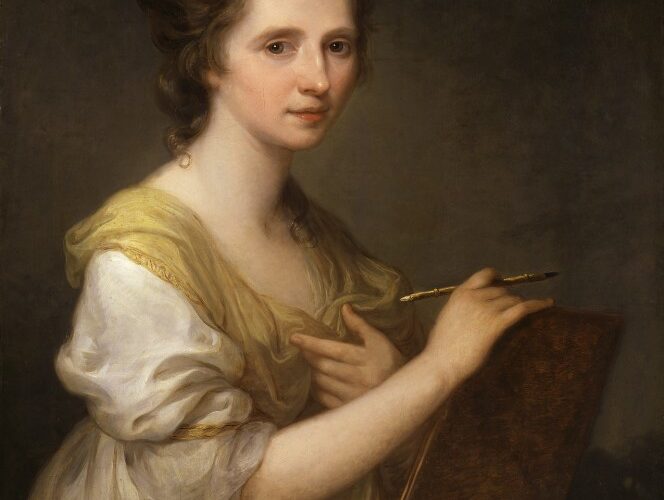Angelica Kauffmann
Theme: The arts in the Age of Revolution, Social and cultural revolution
Angelica Kauffman was a successful and influential artist of the mid-late 1700s, and one of only two female founder members of the Royal Academy of Arts, in London in 1768. Despite also being a skilled portrait and landscape artist, she is remembered primarily for her success as a history painter. This was seen as the most elite category in academic painting at the time, and an unusual choice for a female artist.
Angelica Kauffman (1741 – 1807) was born in Switzerland. Her father, also a painter, recognised his daughter’s artistic talents from an early age and taught her himself as the family journeyed between Austria, Switzerland and Italy. In Italy, she established a reputation as a brilliant artist and was elected a member of the Academy of Fine Arts in Florence. In 1766, Kauffman moved to London where she established a close friendship with the British painter Joshua Reynolds and developed her reputation as a great painter of ancient historical scenes.
When the Royal Academy of Arts was established by King George III in 1768, she and Mary Moser were the only two women of thirty four invited to become founder members. As in most other areas of life in the 1700s, male and female members were not treated equally. However, Angelica Kauffman gained influential status within the Academy. In 1775 she refused to allow a painting – The Conjurer by Nathaniel Hone – to be displayed in the Summer Exhibition, believing it reflected rumours of an affair between her and Joshua Reynolds.
In this self-portrait, Angelica Kauffmann projects her identity primarily as an artist, rather than a fashionable woman of society, by painting herself wearing ‘classical’ dress and holding a portfolio and ‘porte-crayon’, containing her charcoal.
Did you know..?
Angelica Kauffman was the last female member of the Royal Academy until the painter Annie Swynnerton was elected in 1922.
Use our Classroom resources to investigate this object and the Arts in the Age of Revolution further.
Highlights:
- Using objects, artworks and other sources to find out about the past
- Using museum collections as creative starters
And much more…
Sources & acknowledgements
This object description and its related educational resources were researched and written by our team of historians and education specialists. For further information see the item’s home museum, gallery or archive, listed above.
-
Did you know..?
Angelica Kauffman was the last female member of the Royal Academy until the painter Annie Swynnerton was elected in 1922.
-
Education overview
You can access a range of teachers resources related to this object and more on our education page.
Please also see our glossary of terms for more detailed explanations of the terms used.
-
Curatorial info
- Originating Museum: National Portrait Gallery
- Accession Number: NPG 430
- Production Date: c. 1770-1775
- Creator: Angelica Kauffmann
- Material: Oil on canvas
- Size: 737 mm x 610 mm
- Original record
-
Use this image
You can download this image for personal and educational use but please take note of the license type and rights holder information.
- Rights Holder: © National Portrait Gallery, London
- License Type:



